|
|
Brief
information on
|
|
Nippon Kogaku
Japan / Nikon Ultra-Micro-NIKKOR lens series & other special purpose Nikkor lenses
for industrial/scientific/medical/laboratory research etc. usage
|
 |
During the period of '60~'70, Japan had already successfully
emerged from ashes of war where domestically has stepped into a booming economic
cycle. Industrialization would not only create jobs or wealth but also being the
drive force for many secondary supportive industries. For an instance, it started
with a demand for local suppliers in providing various precision equipment manufacturers
such as integrated circuits manufacturing in semiconductor industry, in turns to
satisfy the need to serve high quality precision inspection instruments may then,
eventually relate to Japan premier optical manufacturers. To serve purpose in each
industry and/or special application, Nikon had introduced a series of industrial
grade Ultra-Micro-NIKKOR lens series with very special lens characteristic of extremely
high resolution and magnification. Each of these lenses within the series has resolving
power beyond general usage where some may even exceeding 1,000 lines/mm !.
In relation to how Nippon Kogaku was actually being involved into development of
the Ultra-Micro-NIKKOR lenses, here is an interesting background story written by Michio Akiyama, it explained the origin which gave
rise to these special class of NIKKOR lens series. Although the 1962 Ultra-Micro-NIKKOR
105/2.8 was the first Nikkor lens which bear unique trade name of Ultra-Micro-NIKKOR
(short as "UMN"), but personally I would think the 1958's
Micro-Nikkor 1:5 f=7cm, 1960's Micro-Nikkor 150/5.6 had already possessed all the
fundamental lens characteristic as forerunner model of the Nikon Ultra-Micro-NIKKOR.
<<<--- Cover of a Nikon Product Brochure published in 1982
on the Ultra-Micro-Nikkor lenses, where content in this site are largely based on.
|
| |
|
Anyway, basic info on known Ultra-Micro-Nikkor lenses
existed so far that I can gather are as followed :-
Ultra-Micro-NIKKOR:- Nippon Kogaku Japan Ultra-Micro-NIKKOR 1:1.8 f=28mm (1965);
Ultra-Micro-NIKKOR 1:1.8 f=28mm M=1/10X / M=1/10X
e / M=1/10X
h / M=1/10X
ew / M=1/10X
hw, Nikon Ultra-Micro-NIKKOR 1:1.7 f=28mm M=1/10Xg,
Nippon Kogaku Japan 1:1.2 f=29.5mm (1964); Nikon Ultra-Micro-NIKKOR 1:1.2 f= 30mm, M=1/25X (1969), Nippon Kogaku Japan Ultra-Micro-NIKKOR 1:2 f=55mm
M=1/4X
/ M=1/4X h (1965), Nippon Kogaku Japan Ultra-Micro-NIKKOR 1:1.8 f=50mm M=1/5X h
(1969), Nippon Kogaku Japan Ultra-Micro-NIKKOR 1:1.8 f=50mm M=1/5X e (1969),
M=1/5X h, Nippon Kogaku Japan 1:2.8 f=105mm (1962), Nippon Kogaku Japan Ultra-Micro-NIKKOR
1:2.8 f=125mm M=1/25X (1965), Nippon Kogaku Japan Ultra-Micro-NIKKOR 1:4 f=135mm
M=1/25X (1965), Micro-Nikkor 1:5.6 f=150mm (1960); Nippon Kogaku Japan Ultra-Micro-NIKKOR
1:4 f=155mm, Nippon Kogaku Japan Ultra-Micro-NIKKOR 1:4 f=165mm M=1/10X (1970), Nippon
Kogaku Japan Ultra-Micro-NIKKOR 1:1.0 f=225mm (1969), Nippon Kogaku Japan Ultra-Micro-NIKKOR
1:1.0 f=250mm (1968); Nippon Kogaku Japan Ultra-Micro-NIKKOR 1:1.4 f=300mm (1969); usable adapter Nikon Reverse
Adapter 40.5mm). red M/magnification, with alphabet e, h, or g are denoting different
wavelengths.
Note:- Visitors are welcome to beef up the content of these information
data base. You may contact via Message Board and/or write to my long time web buddy, Rick Oleson <e-mail:
rick_oleson@yahoo.com> Thank You. |
|
|
Background and History
The diffraction theory of light imposes theoretical limitations on resolving power
of a lens, the limit depending on the lens speed i.e. f/number. This limit can be
determined by the lens speed, magnification ratio and wavelength used. In other words,
the resolving power at the center portion of an aberation-FREE lens has the following
relationship:- resolving power = 
The resolving power of a lens closely associates to its aperture. Although there
are other variable factors and for decades, even optical engineers may face the same
issues in designing a high quality lens. Regardless, with a working lens, often we
use of mid or small aperture as part of a solution to achieve the best of an optical
lens. But as far as delivering super high resolution lenses are concerned, it can
be a different story. In 1961, Nikon had first developed a high resolution optic,
Ultra-Micro-NIKKOR 105mm f/2.8 e-line-type with very unique lens characteristic of
limiting the picture angle as well as range of chromatic aberration corrections to
the narrow wavelength band of green light to which the ultrahigh resolution orthochromtic
photoplate sentitizer responds -essentially critical to meet the demanding needs
and necessary standard by the electronic industry in the mass production of IC (integrated
Circuits) and LSI miniaturized circuits.
During the period, for an instance, prior to mass production of IC and LSI, is the
preparation of photomask-negatives measuring 5 square centimeters (cm), with central
3-5 sq. cm area covered by a few hundreds or thousands of micro-patterns of identical
configuration. Quality of finished IC/LSI deprives directly from the degree of precision
reflected by these photomarks. Similarly, accuracy of photomasks also depends on
the lenses which are used to print them. So, these lenses would require an ultrahigh
resolving power, so do those which were used to project the image of the photomask
onto the silicon wafer from which the final product was then manufactured.
So, the lens used in the manufacturing would play an extremely important part in
the whole process of manufacturing for this highly specialized field of industrial
microphotography and precision necessity in the mass production of IC and LSI miniaturized
circuits. It was the ensuing age of integrated circuitry that had prompted birth
of the Ultra-Micro-NIKKOR series of lenses by Nikon. In 1965, Ultra-Micro-NIKKOR
1:1.2 f=30mm for industrial usage was awarded by Japan Science and Technology Agency
award for Nikon effort in delivering solution to the precision manufacturing industry.
Naturally, this was how it was started, but as in the fast moving world of electronic
manufacturing, the early model was followed by series of other Ultra-Micro-NIKKOR
lenses to cater for different specifications, requirements and purposes in the same
field. We have mentioned the Ultra-Micro-NIKKOR 105mm f/2.8 w/e-line-type earlier.
But the advent of even more sophisticated IC technology involving line widths of
only 1nm made silver halide emulsions too thick for practical purpose; so chrome-plated
photmasks with photo-resist as their photo-sentitizer were developed at later stage.
This in turns gave birth to the h-line Ultra-Micro-NIKKOR lens group in order to
meet the new wavelength requirement in the renewed way of large scale IC and LSI
miniaturized circuits manufacturing process. In 1969, two new exotic ultrahigh lens
speed g-lined series Ultra-Micro-NIKKOR 1:1g f=225mm and Ultra-Micro-NIKKOR 1:4g
f=300mm projection printing lenses were developed to meet such new advances in IC
production technology and to solve the problem caused by conventional contact printing
where photomasks and silicon wafer inevitably become scratched. But as in 1:1 projection
printing, masks and wafers do not come into physical contact and hence eliminates
any chances of abrasion.
From then on, there were Two GROUPs of Ultra-Micro-NIKKOR lenses:- Broadly classified
according to their photo-sentitive materials, there was sufficient variety in the
two groups of Ultra-Micro-NIKKOR lenses to match the varying picture sizes, reduction
ratios and other demanding technical requirements. With Group one, e-line Ultra-Micro-NIKKOR,
lenses in this group are used mainly with high resolution photo plates of silver
halide emulsion, using e-line. Main lens characteristics are minimal aberration and
consequent super high resolving power, makes them come extremely close to ideal reproduction.
Group two, consists of the g-line and h-line Ultra-Micro-NIKKOR.
Lenses in this group are required when photo-resist (photosensitive resin) was used
as the sentitizer. Basically the main difference was, using a shorter wavelength
than the e-line group, the g/h-line series provide a higher resolving power. For
an instance, the high speed UMN 1:1 225mm and 1.4 300mm g-line lenses were used for
printing of phtomask images onto wafers and they can print as fine as 2nm over an
entire picture area without image distortion as Nikon claimed the respective lens
constructions were perfectly symmetrical.
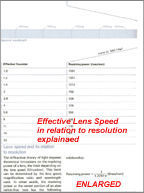 |
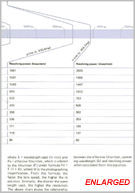
|
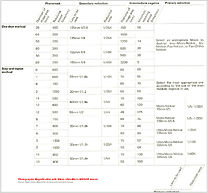 |
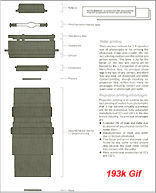 |
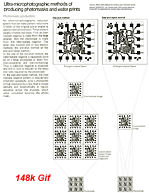 |
Warmth Reminder: these are essentially materials or method used during the '70~'80,
may not be applicable for modern days manufacturing anymore, just reading reference
only.
|
| |
|
|
|
|
|
Why would it need such a high lens speed for the 225mm
f/1.0, 250mm f1.0 and 300mm/1.4 ? Nikon explained :- " ..Where  =wavelength used (in mm) and Fe (effective
f/number), which is related to the f/number (F) under formula Fe=F(1+M)
("M" =photographing magnification). From this equation, the faster the
lens speed, the higher the resolution. Similarly, the shorter the wavelength used,
the higher the resolution. The chart presented the relationship between the effective
f/-number, operating wavelength ( =wavelength used (in mm) and Fe (effective
f/number), which is related to the f/number (F) under formula Fe=F(1+M)
("M" =photographing magnification). From this equation, the faster the
lens speed, the higher the resolution. Similarly, the shorter the wavelength used,
the higher the resolution. The chart presented the relationship between the effective
f/-number, operating wavelength (  and resolving power when calculated from the
formula..". and resolving power when calculated from the
formula..".
<<<--- Above left image: Relationship between the effective
f/-number, operating wavelength (64k Gif); Far left: Relationship of an aberation-free
lens and resolving power at the center . Last chart: Photographic Magnification reference
chart for various UMN lenses in one-shot or step & repeat process. Photomask
and wafer printing/ one shot and step and repeat process in large scale IC/LSI manufacturing.
Note: A micrometre is one-millionth of a metre (1/1000 of a millimetre,
or 0.001mm). Its unit symbol in the International System of Units (SI) is µm.
The nanometre was formerly called also millimicron,since it is 1/1000 of a micron,
and was often denoted by the symbol mµ or (more rarely) µµ. or
A unit of length equal to one thousandth (10-3) of a micrometer or one billionth
(10-9) of a meter. (Mathematics & Measurements / Units) an obsolete name for
a nanometre; one millionth of a millimetre. Useful links: What Wavelength Goes With a Color? |
|
Suggestive applications/usage of Ultra-Micro-NIKKOR lenses As Nikon stated
it in an early '80 sales catalogue: - Although developed primarily for the production
of photomasks for high-frequency semiconductor elements (diodes, transistors, ICs
and LSIs), Ultra-Micro-NIKKOR lenses were useful in other applications such as photo-etching,
for production of evaporation masks by electroforming and of photommasks of filter,
mesh or other minute parts and for direct projection printing of photomarks onto
plates coated with photo resist. Ultra-Micro-NIKKOR lenses were also an ideal choice
for making lens testing charts and producing glass plates on which complex micro-patterns
for optical instruments or even inspection equipment are printed. Another important
application was for ultra-micro photographic reproduction of books, company documents
and literature etc. as ultra-microphotography provides practical solution for those
who may require to handle vast volume of data occupying a minimal amount of space
such as microform of microfilming and microfiche. The lenses were also useful for
those computer systems which require ultra-high density storage of information One
additional application them were for use in testing resolving power of everyday film.
Okay, Nikon had never mentioned if the Ultra-Micro-NIKKOR lenses are too good for
day to day photography or can they be used on a Nikon reflex SLR cameras ? According
to this specific page written by Michio Akiyama' redbook Nikkor website, he is using it and explained how
to use on his Nikon F-bodies. You may consider take a read of his suggestion.
 |
To make navigation easier in the site, we would start
the series by picture angle rather than year introduced:
Nippon Kogaku Japan Ultra-Micro-NIKKOR
1:1.8 f=28mm Year introduced:
1965, Discontinued: No info
Unless there are version that I am not aware with a wider picture angle, within
the UMN series 28mm UMN stays as having the widest picture coverage. Probably it
was also due to nature of its main purpose designed for; while generally, although
linear distortion in a high quality ultrawideangle lens can be overcome but it may
not be the best solution for its application. I have pictures of a few units of the
28/1.8 here with slightly different lens description, the units S/N 28206x shown
at left is without the red M with R=Ratio at the lens data circle.
|
 |
 |
Nippon Kogaku Japan Ultra-Micro-NIKKOR 1:1.8 f=28mm M=1/10 Year introduced/Discontinued: no info
As the Serial Number progresses
to this particular unit w/S/N 28238x, a red M with R=Ratio (M=1/10) has been included
at the lens data ring. With f/1.8, this relatively unknown Nikkor 28mm can claimed
to be the fastest 28mm wideangle made by Nikon until 1993 with the debut of AF Nikkor 28mm f/1.4D. In fact, the Ultra-Micro-NIKKOR 1:1.8 f=28mm was introduced
much earlier than the 35mm F-mount by half a decade where the first Nikkor-N AUTO 1:2
f=28mm was
only being officially introduced in 1971. Naturally, the UMN 28/1.8 wasn't a specific
lens for 35mm reflex SLR.
Unlike some of the later UMN lenses which usually has a g/h/e designation behind
the magnification ratio printed; earlier lenses such as this UMN 28/1.8 lens upgrade
wasn't supply any information. Neither I am a historian nor a keen collector at these,
so other than general overview, you just have to pardon me for not able to deliver
more information. The version has same mount with the 55/1.2 and permits interchangeability.
NOTE: If you are observant
enough, most of the Ultra-Micro-NIKKOR lenses were high speed lenses, reasons given
by Nikon was stated above.
<<<---Below shown the front and rear section
of this UMN
28/1.8.
|

 |
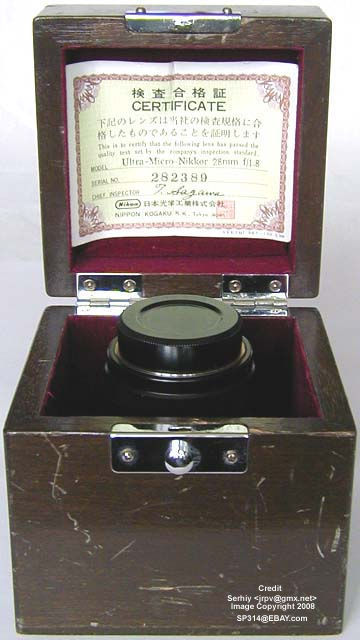 |
<<<---One
thing I like about the older series of Nikon cameras and lenses were their attention
and care given to their products in details, presentations and quality. In particularly
when it relates to 'premium-priced" products, they are very attentive in ensuring
the lens/camera be shown or protected very well. All Ultra-Micro-NIKKOR lenses seemingly
were belonged to the elite product category. It was packed within a solid hardwood
lens case such as shown, padlocked, and enclosed with an quality inspection certificate.
It reminds me with the first Nikon F2 Titan bought many years ago, it also came with
similar class of packing in delivery. Well, these products are history, similarly,
the old Nikon care followed, sad ....huh ?
Below is a typical QC certification
issued with a UMN lens. you may CLICK and take a look at enlarged view.

|
|
Technical Specifications for Nippon Kogaku Japan Micro-Nikkor-NIKKOR 1:1.8 f=28mm
| Ultra-Micro-NIKKOR 1:1.8 f=28mm e-line type |
Ultra-Micro-NIKKOR 1:1.8 f=28mm h-line type |
Ultra-Micro-NIKKOR 1:1.8 f=28mm ew-line type |
Focal Length: 27.5mm
maximum Aperture: f/1.8
Lens Construction: 9 elements in 7 groups
Standard Magnification: 1/10X
Picture Angle: 7.6°
Overall working distance: 315mm
Object area:- 40mm
image area:- 4mm
Standard wavelength: 546 millimicron (e-line)
Aperture efficiency at image corner: 100% @ f/1.8 with 0% vignetting score
Distortion: -0.06%
Aerial resolving power: 700lines/mm
Aperture scale: f/1.8, f/2, f/2.8, f/4, f/5.6, f/8
Lens Mount: Screw d=39mm p=1/26"
Dimension (D) X (L):- 51mm x 70mm
Filter thread size: 40.5mm screw-in type
Weight:- 310g/10.9oz |
Focal Length: 27.6mm
maximum Aperture: f/1.8
Lens Construction: 9 elements in 7 groups
Standard Magnification: 1/10X
Picture Angle: 7.6°
Overall working distance: 315mm
Object area:- 40mm
image area:- 4mm
Standard wavelength: 404.7 millimicron (h-line)/435nm (g-line)
Aperture efficiency at image corner: 100% @ f/1.8 with 0% vignetting score
Distortion: -0.04%
Aerial resolving power: 900 lines/mm
Aperture scale: f/1.8, f/2, f/2.8, f/4, f/5.6, f/8
Lens Mount: Screw d=39mm p=1/26"
Dimension (D) X (L):- 51mm x 71.5mm
Filter thread size: 40.5mm screw-in type
Weight:- 310g/10.9oz |
Focal Length: 28.2mm
maximum Aperture: f/1.8
Lens Construction: 9 elements in 7 groups
Standard Magnification: 1/10X
Picture Angle: 7.6°
Overall working distance: 315mm
Object area:- 80mm
image area:- 8mm
Standard wavelength: 546.1 millimicron (e-line)
Aperture efficiency at image corner: 100% @ f/1.8 with 0% vignetting score
Distortion: -0.02%
Aerial resolving power: 600lines/mm @8mm,
650 lines/mm @7mm, 700 lines/mm@6mm
Aperture scale: f/1.8, f/2, f/2.8, f/4, f/5.6, f/8
Lens Mount: Screw d=39mm p=1/26"
Dimension (D) X (L):- 51mm x 70mm
Filter thread size: 40.5mm, p=0.5mm
Weight:- 330g |
The above outlines the few major versions of the Ultra-Micro-NIKKOR
1:1.8 f=28mm with different line types. The ew-line model, according to the literature,
quoted as the improved version. It was also used in the making of photomarks via
step and repeat process in large-scale Integrated circuitry manufacturing. The lens
mount and working distance of the model has been mentioned were identical to previous
model. But the image size has been enlarged from 4mm to 8mm (image circle). The ew-line
model has the same resolution, up to 600 lines/mm even at image size of 8mm covering
picture area of 5.6mm square.
On the other hand, seemingly the h-line model has an
upgrade as Micro-Nikkor-NIKKOR 1:1.8 f=28mm hw-line type at later stage. It is
used for performing a number of reduced printings onto a glass plate applied with
photo-resist for the making of chrome masks from intermediate negative plate. Similar
to the UMN 28/1.8 ew-line lens, the image size of this upgrade was enlarged to 8mm.
The resolving power delivers beyond 900 lines/mm, and for image areas of 7mm/8mm,
the lens delivers 800 lines/mm and 750 lines/mm - the highest score among all the
Ultra-Micro-NIKKOR 1:1.8 f=28mm featured above. Although the optical design literally
remained the same, but lens measure slightly larger in dimension, besides, the filter
attachment size of the version was slightly larger than the rest @50.5mm.

ref: Nikon Sales Manual, Industry and Science Nikkor Lenses, Technical manual for
Micro-Nikkor-NIKKOR lenses |
|
Ultra-Micro-NIKKOR 1:1.8 f=28mm hw-line type
Focal Length: 28mm
maximum Aperture: f/1.8
Lens Construction: 9 elements in 7 groups
Standard Magnification: 1/10X
Picture Angle: 7.6°
Overall working distance: 315mm
Object area:- 80mm
image area:- 8mm
Standard wavelength: 435.8 millimicron (g-line)/404.7 millimicron (h-line)
Aperture efficiency at image corner: 100% @ f/1.8 with 0% vignetting score
Distortion: -0.003%
Aerial resolving power: 750lines/mm @8mm,
800 lines/mm @7mm, 900 lines/mm@6mm
Aperture scale: f/1.8, f/2, f/2.8, f/4, f/5.6, f/8
Lens Mount: Screw d=39mm p=1/26"
Dimension (D) X (L):- 51mm x 70mm
Filter thread size: 50.5mm, p=0.5mm
Weight:- 330g |
 |
Nippon Kogaku Japan Ultra-Micro-NIKKOR 1:1.8 f=28mm M=1/10 e Year introduced/Discontinued: no info
This particular UMN 28/1.8 with a S/N approx. 10k later from the above model
eventually has a e added behind the M=1/10, so it is said to be e-line
specific as indicated. As keen Japanese collector on UMN, Michio Akiyama has explained
UMN with e-line designation would deliver wider tolerance in wavelength to use for
color photography. Not sure if this is the ew-line version as refer to the technical
specification section above.
Note:- I have collected these
images for a long period of time via many sources. I have misplaced the folder which
contained other view of this particular lens and thus, won't able to compare and
examine the rear or side lens barrel section if there are other significant differences
from earlier models.
|
|
 |
 |
Nippon Kogaku Japan Ultra-Micro-NIKKOR 1:1.7 f=28mm M=1/10 g Year introduced/Discontinued: no info
The UMN 28/1.7g could be introduced at much later stage; with an aperture marginally
larger than the 28/1.8, but it doesn't share the same appearance anymore. Basically,
it looks like a lens tube or rather more like a magnifying scope. I am not sure what
would be the correct adapter for this particular version in order to be mounted on
a reflex SLR.
|
 |
| NEXT | 3/7 Nippon
Kogaku K.K. Ultra-Micro-NIKKOR series @ 29.5mm / 30mm and 50/55mm focal length
Index Page:
Nippon
Kogaku K.K. S-Mount rangefinder version Micro-NIKKOR.C 1:3.5 f=5cm (50mm f/3.5)
Page 1:- Micro-NIKKOR
70mm f/5 / Micro-NIKKOR 150mm/5.6 / Macro-NIKKOR Series
:- 19/2.8, 35mm f/4.5, 65mm/4.5, 120mm f/6.3
Page 2:- Ultra-Micro-NIKKOR
Series -28mm focal length models
Page 3:- Ultra-Micro-NIKKOR
Series - 29.5/30mm, 50 & 55mm focal length models
Page 4:- Ultra-Micro-NIKKOR
Series - 105, 125, 135mm & 150mm focal length models
Page 5:- Ultra-Micro-NIKKOR
Series - 155, 165, 225, 250 & 300mm focal length models
Page 6:- General information on other special purpose NIKKOR lenses for industrial.
technical and science applications
Nikon RF-Nikkor lenses:- Main Index Page
W-Nikkor-O 1:4 f=2.1cm | W-Nikkor.C 1:4 f=2.5cm | W-Nikkor.C
1:3.5 f= 2.8cm | W-Nikkor.C 3.5cm lens Group (3.5/2.5/1.8) | Stereo-Nikkor 1:3.5 f=3.5cm | 5cm (50mm) lens group | RF Micro-Nikkor 1:3.5 f=5cm (in progress) | Nikkor-P.C 1:2 f=8.5cm lens group / Nikkor-S.C 1:1.5 f=8.5cm lens group | Nikkor-P.C 1:2.5 f=10.5cm
lens group / Nikkor-T 1:4 f=10.5cm | Nikkor-Q.C 13.5cm lens group: 135/4, 135/3.5 Early
/ Last Version, 135/4 Bellow lens
| Nikkor-H 1:2.5
f=18cm | Nikkor-Q 1:4 f=25cm
| Nikkor-T 1:4.5 f=35cm | Nikkor-T.C 1:5 f=50cm | Reflex-Nikkor 100cm f/6.3
System Accessories
for Nikon Rangefinder cameras
Optical Finders (4 parts):- Fixed Focal length Finders (index page): 2.1cm,
2.5cm, 2.8cm,
3.5cm, 35cm Stereo,
5cm, 8.5cm, 10.5cm,
13.5cm | Variframe / Varifocal / Sport-frames
| Nikon Reflex Housing
Nikon
S36/S72/S250 Motor Drives
/ S36 Manual |
light meters | Nikon RF Flash/Speedlights | Close-up
photography / Repro Copy Outfit / Nikon Bellow Focusing Device (in progress) | Cases/Compartments | Lens & body caps,
Lens Hoods/shades,
Original Price Lists |
packaging/boxes
Instruction
Manuals
RELATIVE:- Nikon Rangefinder (RF) Models | Pictorial History of Nikon
A small visual library on
Nikon Ultra-Micro-Nikkor lenses
Manual Focus Nikkor lenses | Autofocus
Nikkor lenses
Related info:- Leica/Leitz
| Contax/Carl
Zeiss | Seiki Kogaku
(Canon)
| Message Board | lenses | Message Board | RF cameras
Nikon
Auto
Focus
Nikkor lenses:- Main Index Page
Nikon Manual
Focus
Nikkor lenses:- Main Index Page
| Back | Main
Index Page of Pictorial History of Nikon SLRs
about this photographic web site
 |
Home - Photography in Malaysia
|

Credit:- Special thanks to all the contributors of images
and content which made up the basis of the site. Note:certain content and
images appeared in this site were either scanned from official marketing leaflets,
brochures, sales manuals or publications published by Nikon over the years and/or
contribution from surfers who claimed originality of their work for educational purposes.
The creator of the site will not be responsible for may discrepancies arise from
such dispute except rectifying them after verification."Nikon",
"Nikkormat", "Nippon Kokagu KK" & "Nikkor"
are registered trade name of Nikon Corporation Inc., Japan. Site made with an Apple
G5 IMac.
|